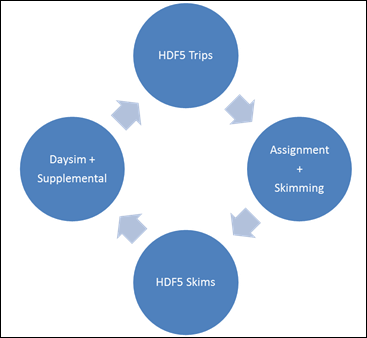PSRC began development of an activity-based model (ABM) for the region several years ago. The ABM has been operational for several months, and in that time PSRC has been testing it in a variety of ways, often running it in parallel with the 4-step model when that model is run, and comparing results. Since the completion of new household travel survey for the region for the year 2014, PSRC plans on updating the ABM accordingly, possibly re-estimating each of the model components, and definitely calibrating/validating the model to the latest survey data. This section details the features of the current trip-based model as well as the ABM.
PSRC's trip-based modeling platform (named 4K) is a typical, aggregate, 4-step travel model with the following key model components.
Fixed factors are used to distribute college, school, and non-home-based trips into time periods, as well as trucks, transit, and non-motorized travel. MNL models are used to distribute the remaining trip purposes. For traffic assignment, the 32 periods are collapsed to five larger time periods.
PSRC's activity-based model (ABM), called SoundCast, was developed in order to answer more diverse transportation planning and policy questions than the trip-based predecessor. It accounts for the drivers of travel demand in a more direct way than the trip-based model, considers more variables that are important for travelers' behaviors, and does so at a much finer grain of detail. The model has been operational for several months but has not been used in an official capacity. The model was estimated and calibrated using 2006 travel survey data and a variety of 2010 base year data. As part of SoundCast's deployment, it is being revised based on a 2014 household travel survey. It is not yet determined whether the model components will be re-estimated. Whether they are or not, the model will be revalidated using the new data.
The overall ABM structure is shown in Figure 4‑1. The system uses a population synthesizer to simulate characteristics and locations of households, DaySim models the “within region” travel of residents, and additional external and commercial trips are added to the trip tables prior to network assignment. Emme is used for network assignment and network skimming processes. Key inputs to SoundCast include the transportation networks and household and employment data, which comes from UrbanSim (a separate land use model).

Figure 4‑1 SoundCast - Activity-Based Model System Architecture
(Source: Reference materials distributed by PSRC to peer review panelists.)
DaySim, the demand model, basically replaces the first three steps of the 4-step model, including trip generation, trip distribution, and mode split. It also replaces the time of day model component, which is not part of the traditional 4-step modeling process. These models are replaced with a number of new models that work at different levels of travel behavior, including long-term choices, day activity level choices, tour level choices, and trip/stop level choices. The model components and structure are shown in Figure 4‑2 and Figure 4‑3.

Figure 4‑2 DaySim Long-Term Model Component Structure
(Source: Presentation materials used by PSRC during peer review meeting.)

Figure 4‑3 DaySim Tour and Trip/Stop Level Model Component Structure
(Source: Presentation materials used by PSRC during peer review meeting.)
DaySim considers a number of variables in the models, including household variables, person variables, tour variables, and trip variables. Household variables include the household location, income, household size, number of workers, and number of vehicles. Person variables include age, gender, worker and student status, hours worked, and work and school locations. Tour and trip variables include the location, tour primary purpose, tour and trip mode, and trip timing.
Once DaySim runs and the supplemental trips are generated (e.g., truck trips and external trips), trips are assigned to the network and new skims/impedances are generated on the basis of the estimated demand. The new skims/impedances are fed back to the demand system and the process repeats, as shown in Figure 4‑4.

Figure 4‑4 SoundCast Data Exchange
(Source: Reference materials distributed by PSRC to peer review panelists.)
The time periods from the SoundCast model are defined as in Table x. Skims are generated for several time periods. For highways, six primary periods are skimmed:
Highway skims are generated for each of 12 periods and transit skims for 5 periods as shown in Table x. Skim attributes include travel times, travel costs, and travel distances for highways, and in-vehicle times by transit vehicle (e.g., ferry, commuter rail, etc.), wait times, access and egress times, transfer times, and number of transfers for transit.
All of the individual DaySim model components were calibrated to match the 2006 household survey, 2010 Census Transportation Planning Products (CTPP), 2010 highway counts, 2006-2010 ACS, and 2010 boarding data. As mentioned above, PSRC has a new 2014 household survey, which will be relied upon to update the model.